A 2D Porous Zinc-Organic Framework Platform for Loading of 5-Fluorouracil
Abstract
:1. Introduction
2. Results and Discussion
2.1. The Crystal Structure of Complex 1
2.2. IR, Thermal, and Chemical Stability
2.3. Drug Delivery of 1a for 5-FU
2.4. DFT Simulations
2.5. MTT and Zebrafish Results
3. Materials and Methods
3.1. Materials and Physical Measurements
3.2. Preparations of Complex 1 and Complex 1a
3.3. X-ray Crystal Structural Determination
3.4. Loading of 5-FU
3.5. Release of 5-FU
3.6. Simulation
3.7. Cytotoxicity Assay
3.8. Tests of Zebrafish
3.9. Live Subject Statement
4. Conclusions
Supplementary Materials
Author Contributions
Funding
Data Availability Statement
Acknowledgments
Conflicts of Interest
References
- Galluzzi, L.; Buque, A.; Kepp, O.; Zitvogel, L.; Kroemer, G. Immunological effects of conventional chemotherapy and targeted anticancer agents. Cancer Cell 2015, 28, 690–714. [Google Scholar] [CrossRef] [PubMed] [Green Version]
- Filippousi, M.; Turner, S.; Leus, K.; Siafaka, P.I.; Tseligka, E.D.; Vandichel, M.; Nanaki, S.G.; Vizirianakis, I.S.; Bikiaris, D.N.; Voort, P.V.D.; et al. Biocompatible Zr-based nanoscale MOFs coated with modified poly (ε-caprolactone) as anticancer drug carriers. Int. J. Pharmaceut. 2016, 509, 208–218. [Google Scholar] [CrossRef] [PubMed]
- Kamal, S.; Khalid, M.; Khan, M.S.; Shahid, M. Metal organic frameworks and their composites as effective tools for sensing environmental hazards: An up to date tale of mechanism, current trends and future prospects. Coord. Chem. Rev. 2023, 474, 214859. [Google Scholar] [CrossRef]
- Kamal, S.; Khalid, M.; Khan, M.S.; Shahid, M.; Ahmad, M. A Zinc(II) MOF for recognition of nitroaromatic explosive and Cr(III) ion. J. Solid State Chem. 2022, 315, 123482. [Google Scholar] [CrossRef]
- Zeng, Y.; Xu, G.; Kong, X.; Ye, G.; Guo, J.; Lu, C.; Nezamzadeh-Ejhieh, A.; Khan, M.S.; Liu, J.; Peng, Y. Recent advances of the core-shell MOFs in tumour therapy. Int. J. Pharmaceut. 2022, 627, 122228. [Google Scholar] [CrossRef] [PubMed]
- Yan, J.W.; Wu, J.; Lu, L.; Wang, J.; Guo, J.; Sakiyama, H.; Muddassir, M.; Khan, M.S. Photocatalytic performances and mechanisms of two coordination polymers based on rigid tricarboxylate. J. Solid State Chem. 2022, 316, 123602. [Google Scholar] [CrossRef]
- Chen, J.; Cheng, F.; Luo, D.; Huang, J.; Ouyang, J.; Nezamzadeh-Ejhieh, A.; Khan, M.S.; Liu, J.; Peng, Y. Recent advances in Ti-based MOFs in biomedical applications. Dalton Trans. 2022, 51, 14817–14832. [Google Scholar] [CrossRef]
- Lawson, H.D.; Walton, S.P.; Chan, C. Metal-Organic Frameworks for drug delivery: A design perspective. ACS Appl. Mater. Interfaces 2021, 13, 7004–7020. [Google Scholar] [CrossRef]
- Lazaro, I.A.; Forgan, R.S. Application of zirconium MOFs in drug delivery and biomedicine. Coord. Chem. Rev. 2019, 380, 230–259. [Google Scholar] [CrossRef] [Green Version]
- Horcajada, P.; Chalati, T.; Serre, C.; Gillet, B.; Sebr, C.; Baati, T.; Eubank, J.F.; Heurtaux, D.; Clayette, C.; Kreuz, C.; et al. Porous metal-organic-framework nanoscalecarriers as a potential platform for drug delivery and imaging. Nat. Mater. 2010, 9, 172–178. [Google Scholar] [CrossRef]
- Sun, Y.; Zheng, L.; Yang, Y.; Qian, X.; Fu, T.; Li, X.; Yang, Z.; Yan, H.; Cui, C.; Tan, W. Metal-Organic Framework Nanocarriers for Drug Delivery in Biomedical Applications. Nano-Micro. Lett. 2020, 12, 103. [Google Scholar] [CrossRef] [PubMed]
- Taylor-Pashow, K.M.L.; Rocca, J.D.; Xie, Z.; Tran, S.; Lin, W. Post-synthetic modifications of iron-carboxylate nanoscale metal-organic frameworks for imaging and drug delivery. J. Am. Chem. Soc. 2009, 131, 14261–14263. [Google Scholar] [CrossRef] [PubMed] [Green Version]
- Feng, D.; Liu, T.F.; Su, J.; Bosch, M.; Wei, Z.; Wan, W.; Yuan, D.; Chen, Y.P.; Wang, X.; Wang, K.; et al. Stable metal-organic frameworks containing single-molecule traps for enzyme encapsulation. Nat. Commun. 2015, 6, 5979. [Google Scholar] [CrossRef] [PubMed] [Green Version]
- Zhuang, J.; Kuo, C.H.; Chou, L.Y.; Liu, D.Y.; Weerapana, E.; Tsung, C.K. Optimized Metal-organic framework nanospheres for drug delivery: Evaluation of small-molecule encapsulation. ACS Nano 2014, 8, 2812–2819. [Google Scholar] [CrossRef] [PubMed]
- Hu, Q.; Yu, J.; Liu, M.; Liu, A.; Dou, Z.; Yang, Y. A low cytotoxic cationic metal-organic framework carrier for controllable drug release. J. Med. Chem. 2014, 57, 5679–5685. [Google Scholar] [CrossRef]
- Rojas, S.; Colinet, I.; Cunha, D.; Hidalgo, T.; Salles, F.; Serre, C.; Guillou, N.; Horcajada, P. Toward understanding drug incorporation and delivery from biocompatible metal-organic frameworks in view of cutaneous administration. ACS Omega 2018, 3, 2994–3003. [Google Scholar] [CrossRef]
- Horcajada, P.; Serre, C.; Vallet-Regi, M.; Sebban, M.; Taulelle, F.; Ferey, G. Metal-organic frameworks as efficient materials for drug delivery. Angew. Chem. Int. Ed. 2006, 45, 6120–6124. [Google Scholar] [CrossRef]
- Bag, P.P.; Wang, D.; Chen, Z.; Cao, R. Outstanding drug loading capacity by water stable microporous MOF: A potential drug carrier. Chem. Commun. 2016, 52, 3669–3672. [Google Scholar] [CrossRef]
- Canivet, J.; Fateeva, A.; Guo, Y.; Coasne, B.; Farrusseng, D. Water adsorption in MOFs: Fundamentals and applications. Chem. Soc. Rev. 2014, 43, 5594–5617. [Google Scholar] [CrossRef] [Green Version]
- Greathouse, J.A.; Allendorf, M.D. The Interaction of Water with MOF-5 Simulated by Molecular Dynamics. J. Am. Chem. Soc. 2006, 128, 10678–10679. [Google Scholar] [CrossRef]
- Wang, J.; Ma, D.; Liao, W.; Li, S.; Huang, M.; Liu, H.; Wang, Y.; Xie, R.; Xu, J. A hydrostable anionic zinc-organic framework carrier with a bcu topology for drug delivery. CrystEngComm 2017, 19, 5244–5250. [Google Scholar] [CrossRef]
- Ma, D.Y.; Xie, J.; Zhu, Z.; Huang, H.; Chen, Y.; Su, R.; Zhu, H. Drug delivery and selective CO2 adsorption of a bio-based porous zinc-organic framework from 2,5-furandicarboxylate ligand. Inorg. Chem. Commun. 2017, 86, 128–132. [Google Scholar] [CrossRef]
- Liang, F.; Qin, L.; Xu, J.; Li, S.; Luo, C.; Huang, H.; Ma, D.; Li, Z.; Xu, J. A hydroxyl-functionalized 3D porous gadolinium-organic framework platform for drug delivery, imaging and gas separation. J. Solid State Chem. 2020, 289, 121544. [Google Scholar] [CrossRef]
- Qin, L.; Ma, D.; Weng, J.; Wen, C.; Dong, Q.; Wu, Z.; Chen, G.; Huang, E.; Chen, Y.; Zheng, J.; et al. A hydrosTable 2D zinc-organic framework carrier used for loading of urea. J. Mol. Struct. 2022, 1247, 131408. [Google Scholar] [CrossRef]
- Qin, L.; Li, Y.; Liang, F.; Li, L.; Lan, Y.; Li, Z.; Lu, X.; Yang, M.; Ma, D. A microporous 2D cobalt-based MOF with pyridyl sites and open metal sites for selective adsorption of CO2. Micropor. Mesopor. Mater. 2022, 341, 112098. [Google Scholar] [CrossRef]
- Li, X.; Yu, Z.; Guan, T.; Li, X.; Ma, G.; Guo, X. Substituent Effects of Isophthalate Derivatives on the Construction of Zinc(II) Coordination Polymers Incorporating Flexible Bis(imidazolyl) Ligands. Cryst. Growth Des. 2015, 15, 278–290. [Google Scholar] [CrossRef]
- Xiao, J.X.; Ma, D.Y. Syntheses, structures, luminescent and catalytic properties of two 3D metal-organic frameworks. Inorg. Chim. Acta 2018, 483, 6–11. [Google Scholar] [CrossRef]
- Sun, C.Y.; Qin, C.; Wang, C.G.; Su, Z.M.; Wang, S.; Wang, X.L.; Yang, G.S.; Zhao, K.Z.; Lan, Y.Q.; Wang, E.B. Chiral nanoporous metal-organic frameworks with high porosity as materials for drug delivery. Adv. Mater. 2011, 23, 5629–5632. [Google Scholar] [CrossRef]
- Singh, P.; Jangir, D.K.; Mehrotraa, R.; Bakhshi, A.K. Development and validation of an infrared spectroscopy-based method for the analysis of moisture content in 5-fluorouracil. Drug Test. Anal. 2009, 1, 275–278. [Google Scholar] [CrossRef]
- Javanbakht, S.; Hemmati, A.; Namazi, H.; Heydari, A. Carboxymethylcellulose-coated 5-fluorouracil@MOF-5 nano-hybrid as a bio-nanocomposite carrier for the anticancer oral delivery. Int. J. Biol. Macromol. 2020, 155, 876–882. [Google Scholar] [CrossRef]
- Song, B.H.; Ding, X.; Zhang, Z.F.; An, G.F. Efficient drug delivery of 5-fluorouracil by a biocompatible Zn-metal-organic framework nanostructure and anti-liver cancer activity study. J. Iran. Chem. Soc. 2019, 16, 333–340. [Google Scholar] [CrossRef]
- Sun, X.Y.; Zhang, H.J.; Sun, Q.; Gao, E.Q. Two cationic iron-based crystalline porous materials for encapsulation and sustained release of 5-fluorouracil. Dalton Trans. 2022, 51, 13263–13271. [Google Scholar] [CrossRef] [PubMed]
- Parsaei, M.; Akhbari, K. MOF-801 as a Nanoporous Water-Based Carrier System for In Situ Encapsulation and Sustained Release of 5-FU for Effective Cancer Therapy. Inorg. Chem. 2022, 61, 5912–5925. [Google Scholar] [CrossRef] [PubMed]
- Sun, X.Y.; Zhang, H.J.; Zhao, X.Y.; Sun, Q.; Wang, Y.Y.; Gao, E.Q. Dual functions of pH-sensitive cation Zr-MOF for 5-Fu: Large drug-loading capacity and high-sensitivity fluorescence detection. Dalton Trans. 2021, 50, 10524–10532. [Google Scholar] [CrossRef]
- Bruker. APEXII Software, Version 6.3.1; Bruker AXS Inc: Madison, WI, USA, 2004.
- Sheldrick, G.M. A short history of SHELX. Acta Cryst. 2008, A64, 112–122. [Google Scholar] [CrossRef] [Green Version]
- Spek, A.L. PLATON, A Multipurpose Crystallographic Tool; Utrecht University: Utrecht, The Netherlands, 2005. [Google Scholar]
- Delley, B. An all-electron numerical method for solving the local density functional for polyatomic molecules. J. Chem. Phys. 1990, 92, 508–517. [Google Scholar] [CrossRef]
- Babarao, R.; Jiang, J. Unraveling the energetics and dynamics of Ibuprofen in Mesoporous metal-organic frameworks. J. Phys. Chem. C 2009, 113, 18287–18291. [Google Scholar] [CrossRef]
- Sun, J.; Remsing, R.C.; Zhang, Y.; Sun, Z.; Ruzsinszky, A.; Peng, H.; Yang, Z.; Paul, A.; Waghmare, U.; Wu, X.; et al. Accurate first-principles structures and energies of diversely bonded systems from an efficient density functional. Phys. Rev. B 1992, 45, 13244–13249. [Google Scholar] [CrossRef]
- Horcajada, P.; Serre, C.; Maurin, G.; Ramsahye, N.A.; Balas, F.; Vallet-Regi, M.; Sebban, M.; Taulelle, F.; Ferey, G. Flexible Porous Metal-Organic Frameworks for a Controlled Drug Delivery. J. Am. Chem. Soc. 2008, 130, 6774–6780. [Google Scholar] [CrossRef]
- Zhao, X.; Wang, S.; Wu, Y.; You, H.; Lv, L. Acute ZnO nanoparticles exposure induces developmental toxicity, oxidative stress and DNA damage in embryo-larval zebrafish. Aquat. Toxicol. 2013, 136–137, 49–59. [Google Scholar] [CrossRef]
- Chen, T.H.; Lin, C.C.; Meng, P.J. Zinc oxide nanoparticles alter hatching and larval locomotor activity in zebrafish (Danio rerio). J. Hazard. Mater. 2014, 277, 134–140. [Google Scholar] [CrossRef] [PubMed]

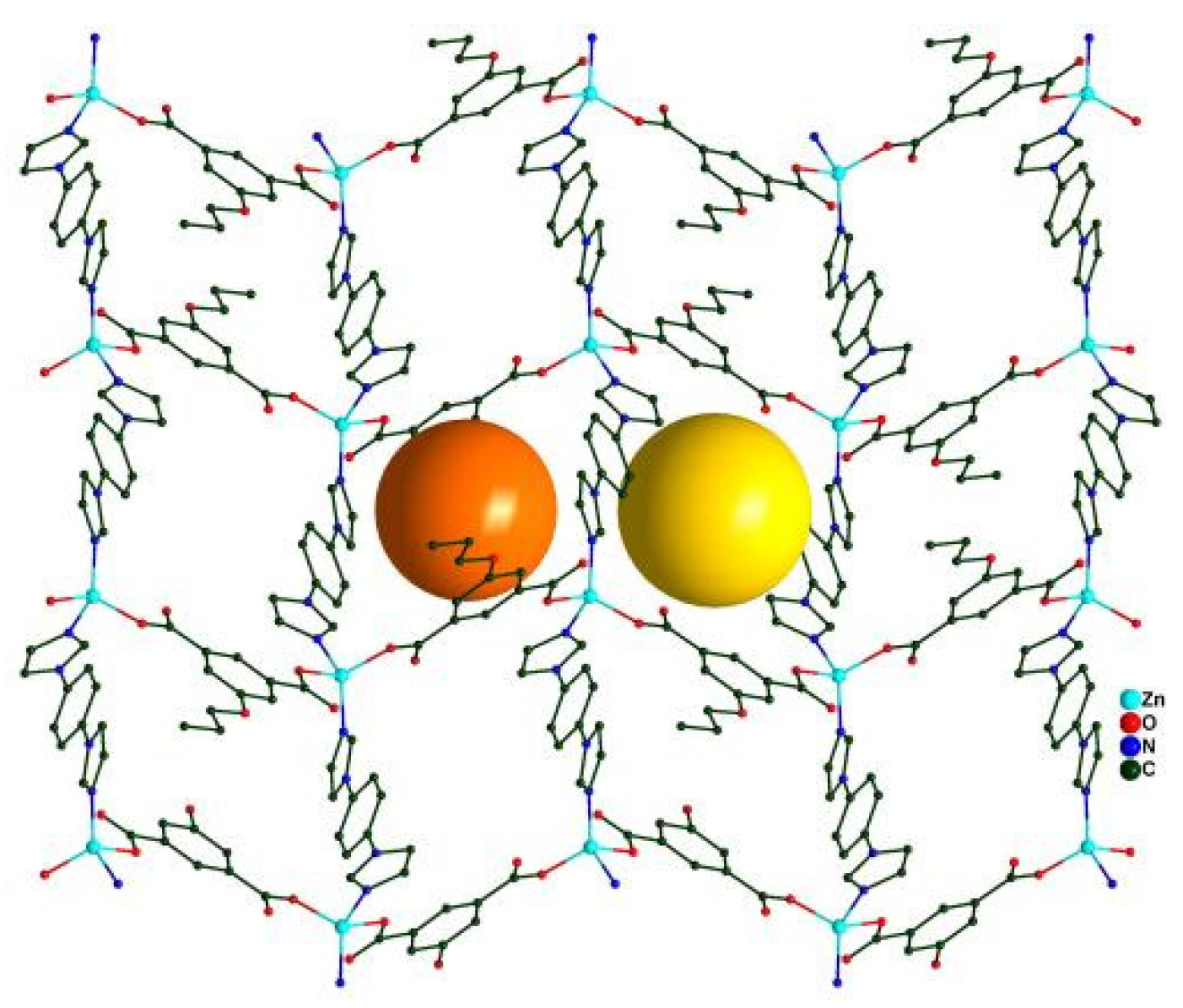


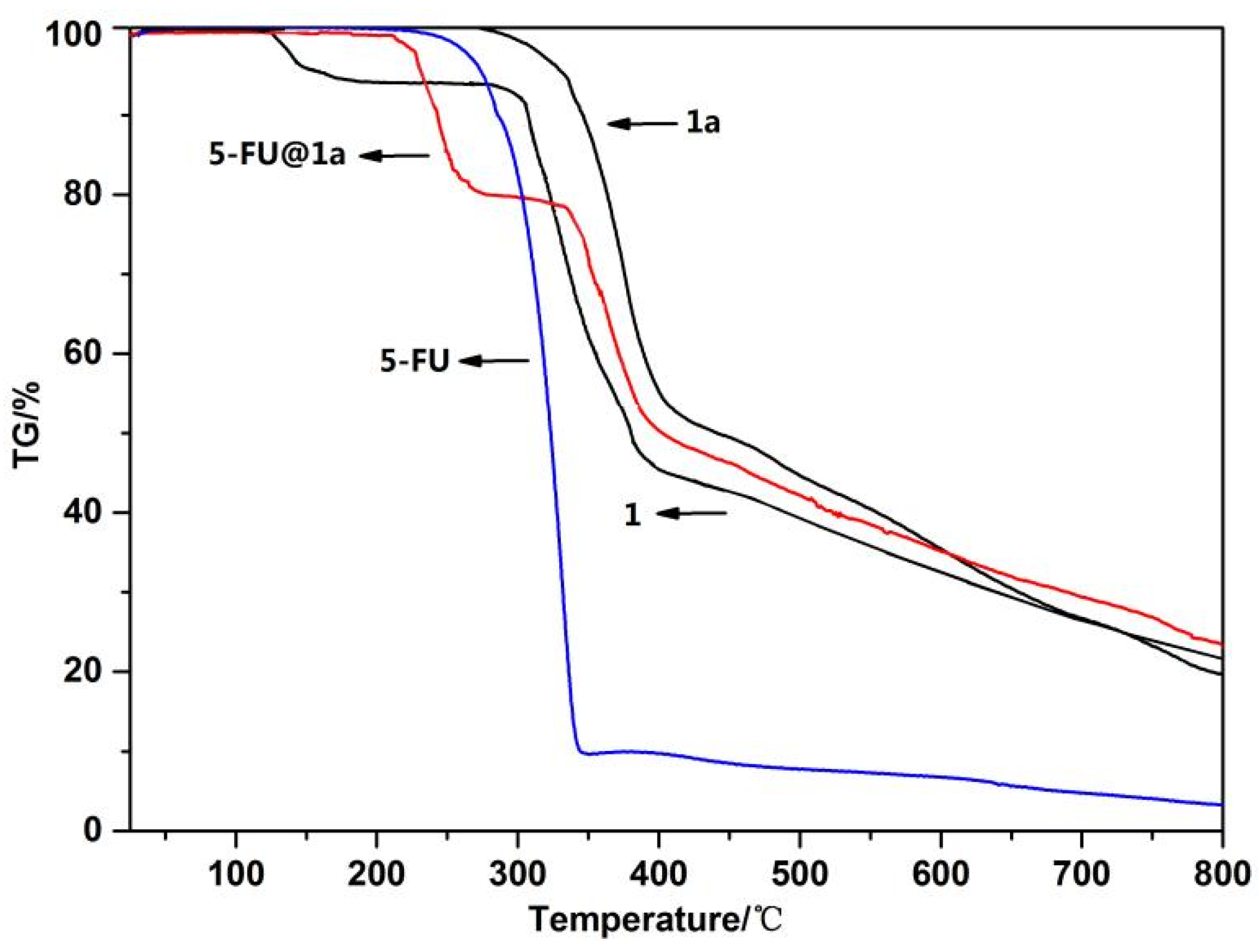
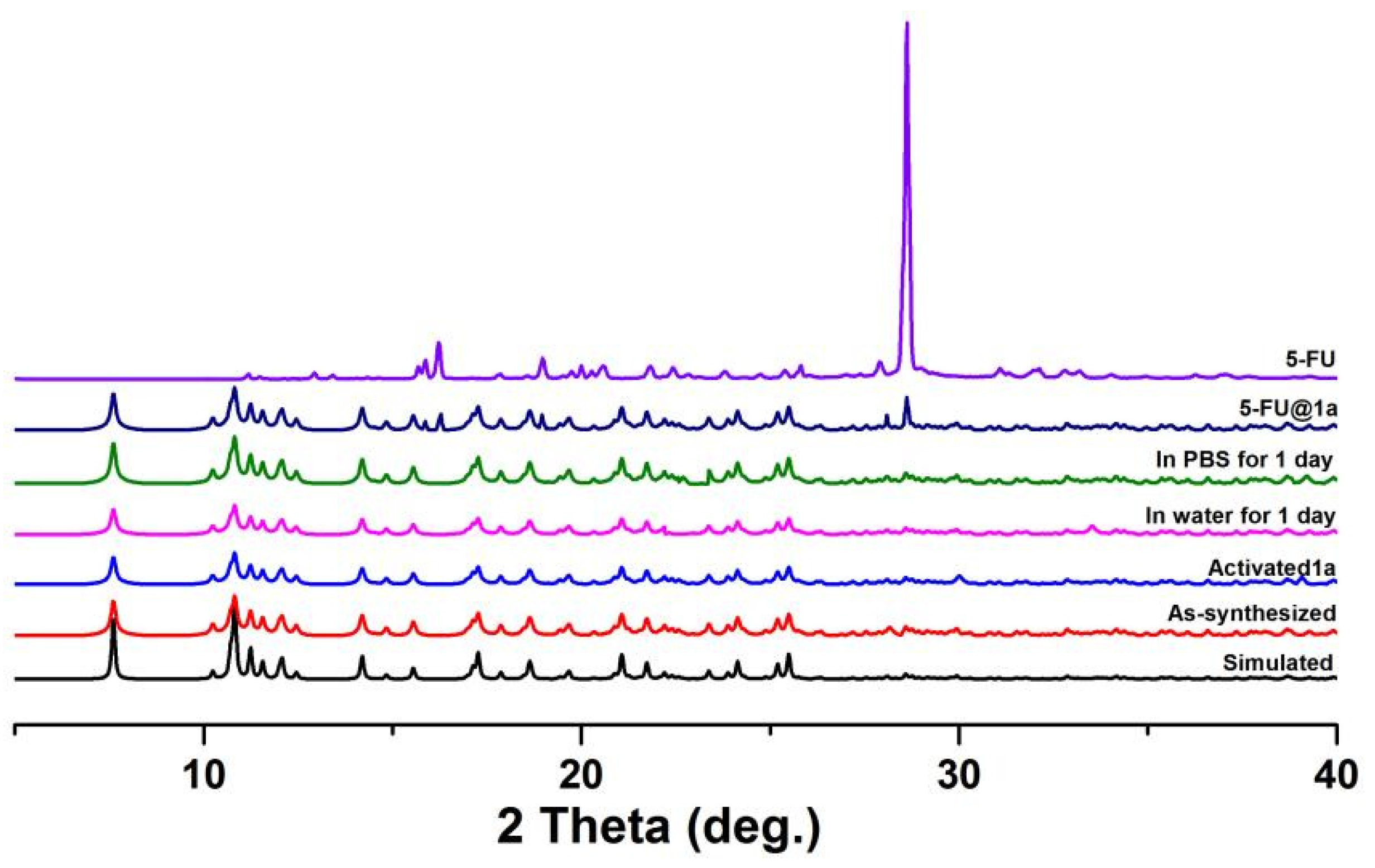
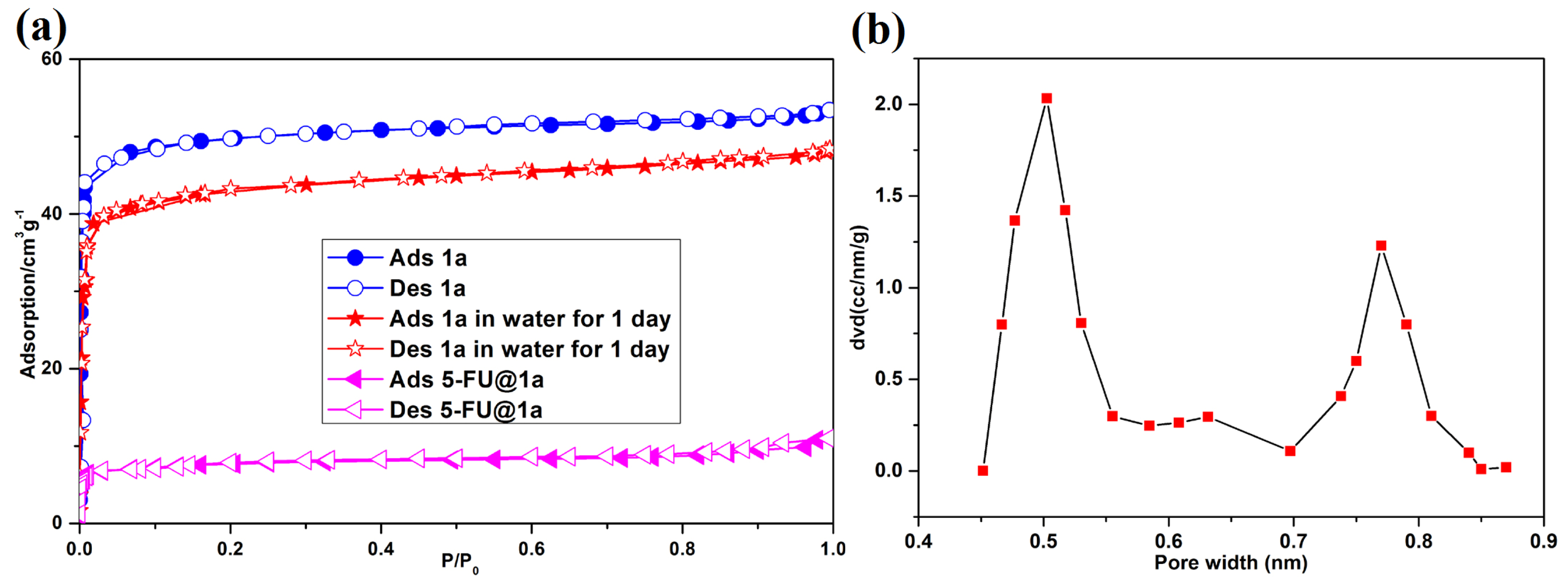
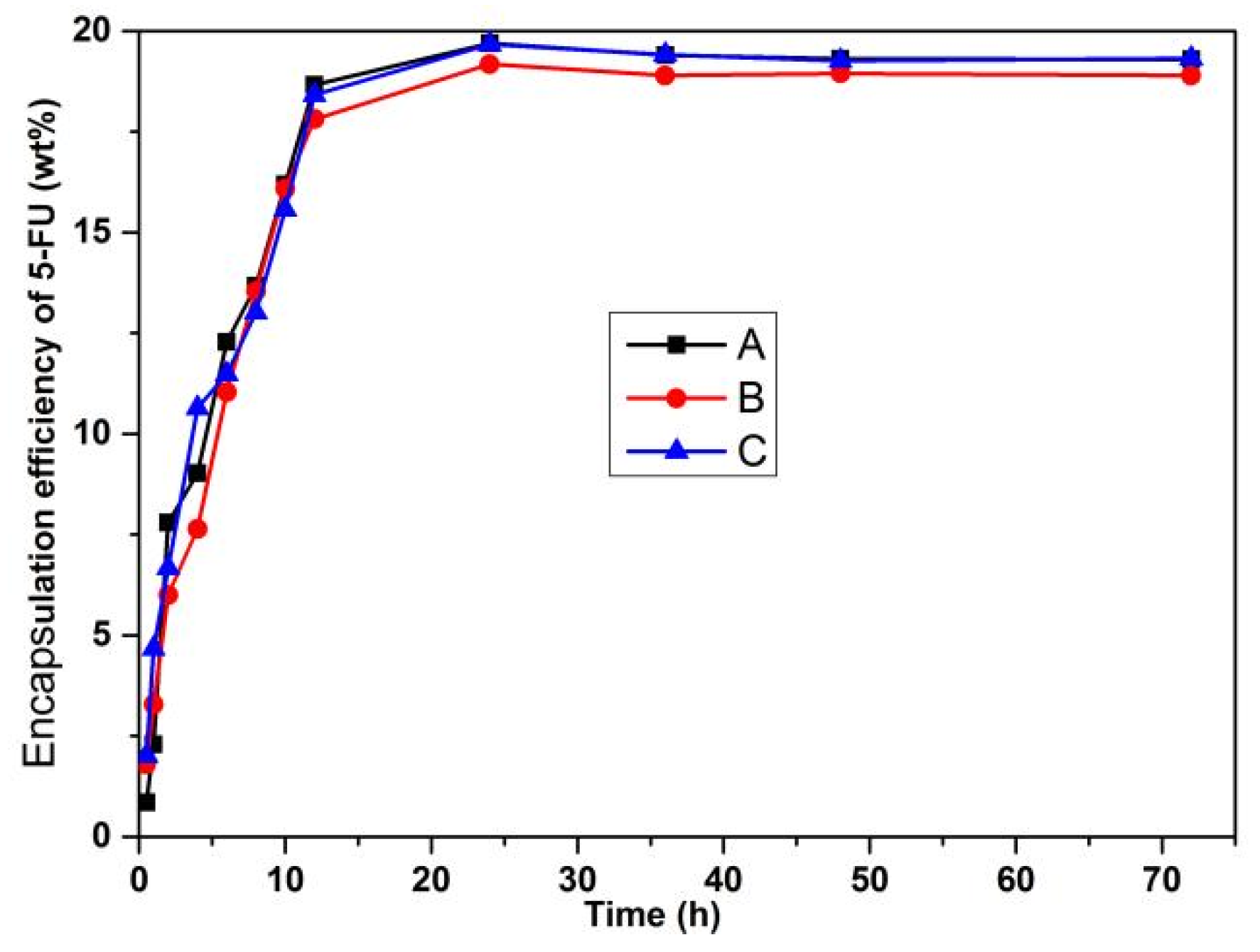
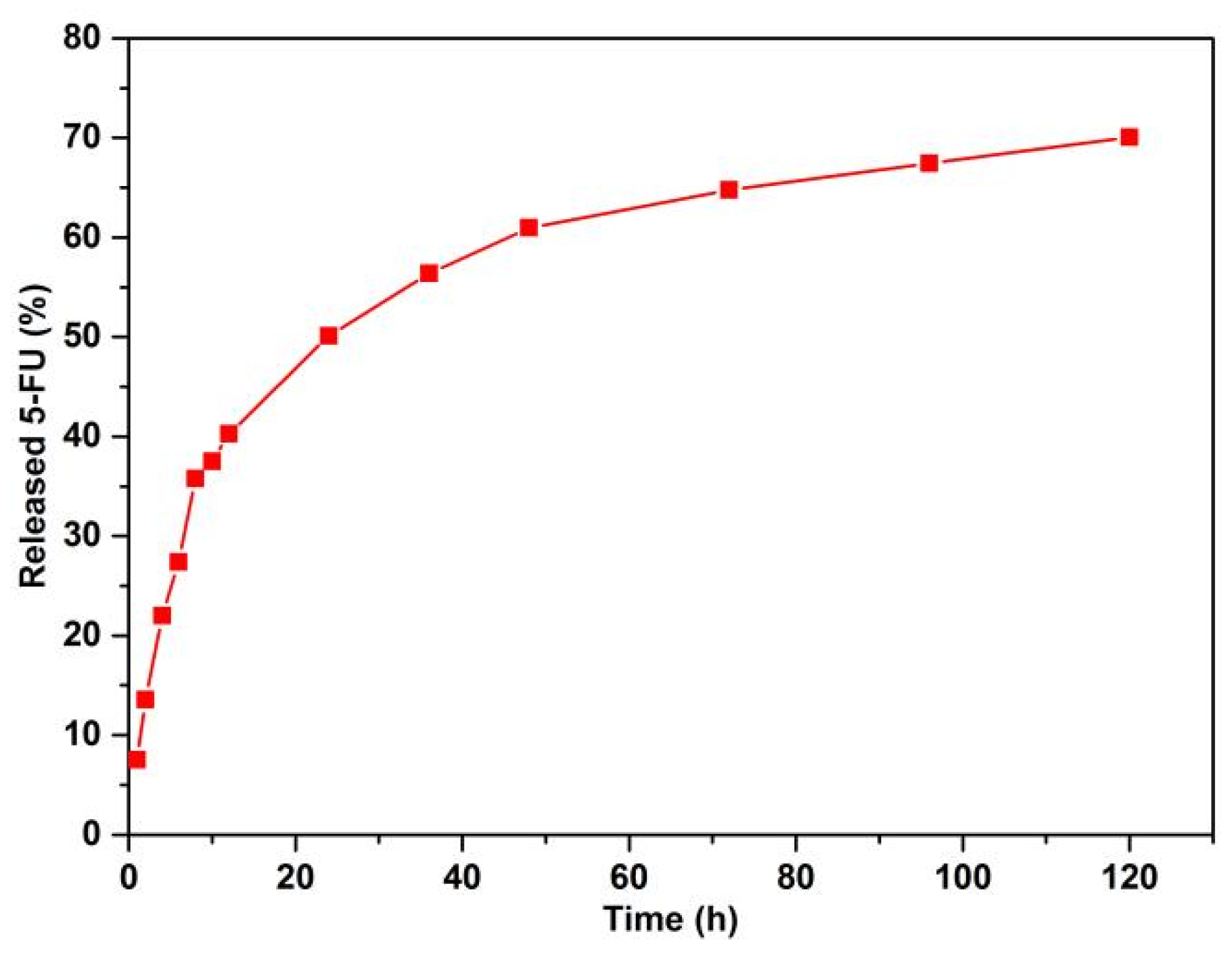
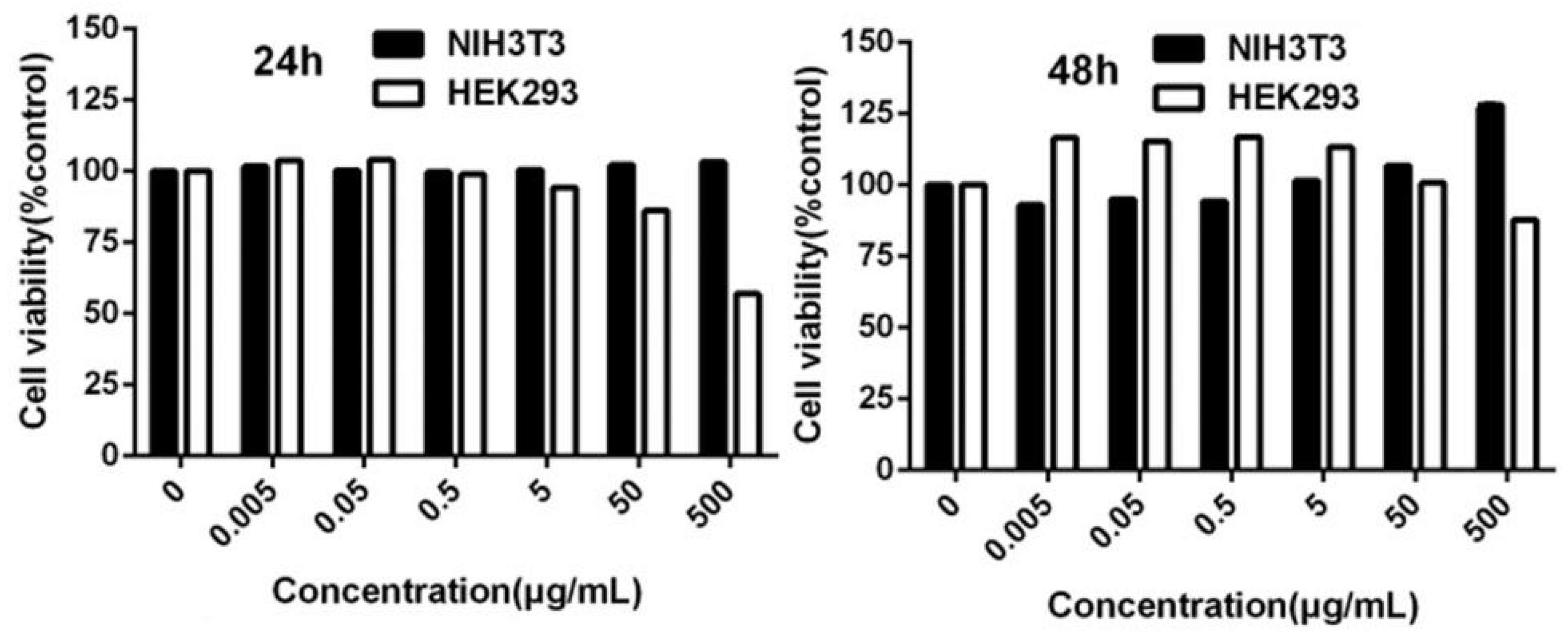
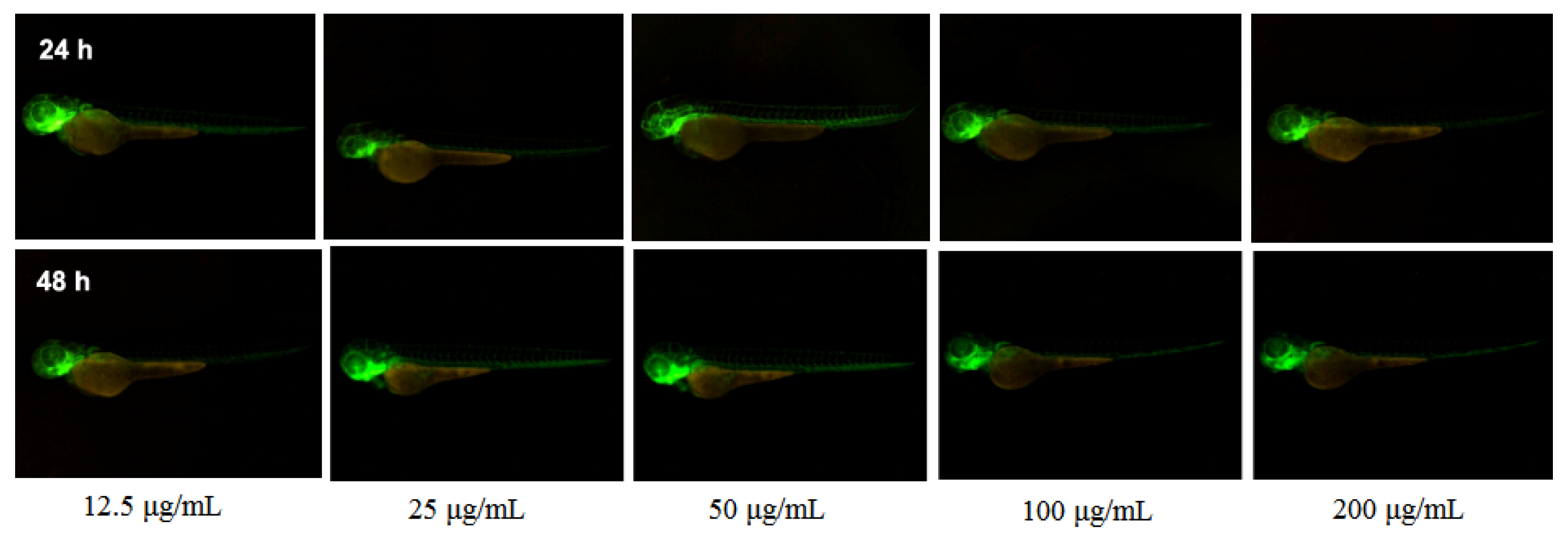
| 5-FU:1a | 1:1 | 1:3 | 1:5 | 3:1 | 5:1 | 7:1 | 10:1 | 15:1 |
|---|---|---|---|---|---|---|---|---|
| Contact times (days) | 1/2/3/4 | 1/2/3/4 | 1/2/3/4 | 1/2/3/4 | 1/2/3/4 | 1/2/3/4 | 1/2/3/4 | 1/2/3/4 |
| Encapsulation efficiency (wt%) | 6.8/7.6/ 8.5/8.0 | 7.9/7.3/ 7.8/6.2 | 9.4/9.9/ 11.0/8.7 | 11.4/11.9/12.5/10.0 | 10.1/11.3/12.1/9.4 | 13.4/14.2 /15.4/11.2 | 15.2/16.8 /19.3/12.3 | 11.2/12.5/12.8/10.1 |
| Formula | C23H20N4O5Zn | Z | 4 |
|---|---|---|---|
| Formula weight | 497.80 | Density (g cm−3) | 1.281 |
| Cystal system | monoclinic | Limiting indices | −12 < h < 12, −21 < k < 15, −21 < l < 19 |
| Space group | P21/n | Reflections collected/unique | 5828/3917 |
| Temperature (K) | 296.15 | Rint | 0.0421 |
| Size (mm) | 0.21 × 0.17 × 0.15 | F(000) | 1024 |
| a (Å) | 9.5699(9) | θ (°) | 2.468–27.587 |
| b (Å) | 16.5045(16) | Goodness-of-fit on F2 | 0.988 |
| c (Å) | 16.4350(16) | R (I > 2σ) | R1 = 0.0431 wR2 =0.0951 |
| β (°) | 96.097(2) | R (all data) | R1 = 0.0768 wR2 =0.1074 |
| V (Å3) | 2581.2(4) | Largest diff. Peak and hole (Å−3) | 0.33, −0.37 |
| Bond Lengths | Value (Å) | Bond Angles | Value (°) |
|---|---|---|---|
| Zn1-O1 | 1.9359(17) | O1-Zn1-O4 i | 109.40(8) |
| Zn1-O4 i | 1.9534(17) | O1-Zn1-N1 | 111.08(8) |
| Zn1-N1 | 1.989(2) | O1-Zn1-N4 ii | 98.37(8) |
| Zn1-N4 ii | 2.021(2) | O4 i-Zn1-N1 | 121.65(8) |
| O4 i-Zn1-N4 ii | 105.97(9) | ||
| N1-Zn1-N4 ii | 107.67(9) |
Publisher’s Note: MDPI stays neutral with regard to jurisdictional claims in published maps and institutional affiliations. |
© 2022 by the authors. Licensee MDPI, Basel, Switzerland. This article is an open access article distributed under the terms and conditions of the Creative Commons Attribution (CC BY) license (https://creativecommons.org/licenses/by/4.0/).
Share and Cite
Qin, L.; Liang, F.; Li, Y.; Wu, J.; Guan, S.; Wu, M.; Xie, S.; Luo, M.; Ma, D. A 2D Porous Zinc-Organic Framework Platform for Loading of 5-Fluorouracil. Inorganics 2022, 10, 202. https://doi.org/10.3390/inorganics10110202
Qin L, Liang F, Li Y, Wu J, Guan S, Wu M, Xie S, Luo M, Ma D. A 2D Porous Zinc-Organic Framework Platform for Loading of 5-Fluorouracil. Inorganics. 2022; 10(11):202. https://doi.org/10.3390/inorganics10110202
Chicago/Turabian StyleQin, Liang, Fenglan Liang, Yan Li, Jiana Wu, Shiyuan Guan, Meiyin Wu, Shiling Xie, Manshi Luo, and Deyun Ma. 2022. "A 2D Porous Zinc-Organic Framework Platform for Loading of 5-Fluorouracil" Inorganics 10, no. 11: 202. https://doi.org/10.3390/inorganics10110202
APA StyleQin, L., Liang, F., Li, Y., Wu, J., Guan, S., Wu, M., Xie, S., Luo, M., & Ma, D. (2022). A 2D Porous Zinc-Organic Framework Platform for Loading of 5-Fluorouracil. Inorganics, 10(11), 202. https://doi.org/10.3390/inorganics10110202











